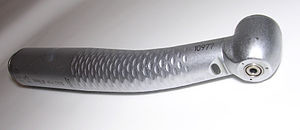Dental Drill
A Dental drill or dentist’s drill is a small, high-speed drill used during dental procedures, usually to remove decay and shape tooth structure prior to the insertion of a filling or crown. A dental drill may also be used in the cleaning and shaping of root canals during endodontic treatment, or to remove old or temporary fillings or crowns prior to the insertion of new or permanent restorations. The term “dental drill” is considered the more colloquial form of the term “dental handpiece,” although it can also be construed as to include the power source for one or more handpieces, a “dental engine.” “Handpiece” and “engine” are more generic and euphemistic terms for generic dental tools. Modern dental drills can rotate at up to 400,000 rpm, and generally use hard metal alloy bits known as burs. Dental burs come in a great variety of shapes designed for specific applications. They are often made of steel with a tungsten carbide coating, or of tungsten carbide entirely. The bur may also have a diamond coating. Dental drills, which have a distinctive, shrill sound, are often a prominent factor in many people’s fear of dentistry.
A Review of Electric Handpieces
The most important change to my dental equipment repairs business in the past 10 years has been the introduction of the electric handpiece with high precision bearings and motors. With the latest versions of electric motors and handpieces, the noise level has become less and less – I check vibration doing repairs! Most of my clients (dentists or dental technicians) comment on the difference in the sound; that it makes their patient experience much better. This low level of sound is of great benefit to the dental team and patient’s ears.
Sources:
